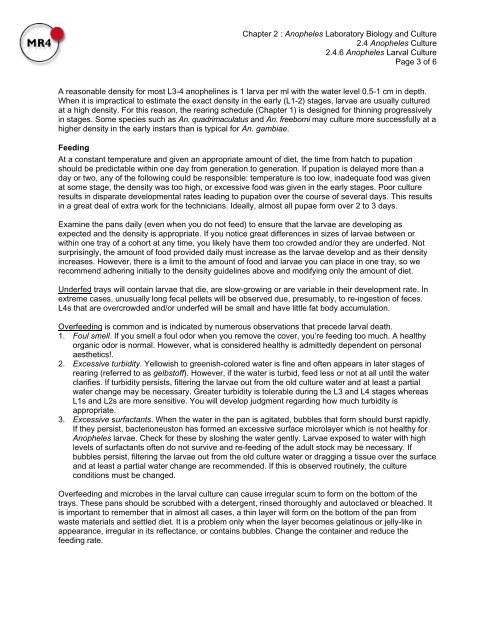Methods in Anopheles Research - MR4
Methods in Anopheles Research - MR4
Methods in Anopheles Research - MR4
- No tags were found...
You also want an ePaper? Increase the reach of your titles
YUMPU automatically turns print PDFs into web optimized ePapers that Google loves.
Chapter 2 : <strong>Anopheles</strong> Laboratory Biology and Culture2.4 <strong>Anopheles</strong> Culture2.4.6 <strong>Anopheles</strong> Larval CulturePage 3 of 6A reasonable density for most L3-4 anophel<strong>in</strong>es is 1 larva per ml with the water level 0.5-1 cm <strong>in</strong> depth.When it is impractical to estimate the exact density <strong>in</strong> the early (L1-2) stages, larvae are usually culturedat a high density. For this reason, the rear<strong>in</strong>g schedule (Chapter 1) is designed for th<strong>in</strong>n<strong>in</strong>g progressively<strong>in</strong> stages. Some species such as An. quadrimaculatus and An. freeborni may culture more successfully at ahigher density <strong>in</strong> the early <strong>in</strong>stars than is typical for An. gambiae.Feed<strong>in</strong>gAt a constant temperature and given an appropriate amount of diet, the time from hatch to pupationshould be predictable with<strong>in</strong> one day from generation to generation. If pupation is delayed more than aday or two, any of the follow<strong>in</strong>g could be responsible: temperature is too low, <strong>in</strong>adequate food was givenat some stage, the density was too high, or excessive food was given <strong>in</strong> the early stages. Poor cultureresults <strong>in</strong> disparate developmental rates lead<strong>in</strong>g to pupation over the course of several days. This results<strong>in</strong> a great deal of extra work for the technicians. Ideally, almost all pupae form over 2 to 3 days.Exam<strong>in</strong>e the pans daily (even when you do not feed) to ensure that the larvae are develop<strong>in</strong>g asexpected and the density is appropriate. If you notice great differences <strong>in</strong> sizes of larvae between orwith<strong>in</strong> one tray of a cohort at any time, you likely have them too crowded and/or they are underfed. Notsurpris<strong>in</strong>gly, the amount of food provided daily must <strong>in</strong>crease as the larvae develop and as their density<strong>in</strong>creases. However, there is a limit to the amount of food and larvae you can place <strong>in</strong> one tray, so werecommend adher<strong>in</strong>g <strong>in</strong>itially to the density guidel<strong>in</strong>es above and modify<strong>in</strong>g only the amount of diet.Underfed trays will conta<strong>in</strong> larvae that die, are slow-grow<strong>in</strong>g or are variable <strong>in</strong> their development rate. Inextreme cases, unusually long fecal pellets will be observed due, presumably, to re-<strong>in</strong>gestion of feces.L4s that are overcrowded and/or underfed will be small and have little fat body accumulation.Overfeed<strong>in</strong>g is common and is <strong>in</strong>dicated by numerous observations that precede larval death.1. Foul smell. If you smell a foul odor when you remove the cover, you’re feed<strong>in</strong>g too much. A healthyorganic odor is normal. However, what is considered healthy is admittedly dependent on personalaesthetics!.2. Excessive turbidity. Yellowish to greenish-colored water is f<strong>in</strong>e and often appears <strong>in</strong> later stages ofrear<strong>in</strong>g (referred to as gelbstoff). However, if the water is turbid, feed less or not at all until the waterclarifies. If turbidity persists, filter<strong>in</strong>g the larvae out from the old culture water and at least a partialwater change may be necessary. Greater turbidity is tolerable dur<strong>in</strong>g the L3 and L4 stages whereasL1s and L2s are more sensitive. You will develop judgment regard<strong>in</strong>g how much turbidity isappropriate.3. Excessive surfactants. When the water <strong>in</strong> the pan is agitated, bubbles that form should burst rapidly.If they persist, bacterioneuston has formed an excessive surface microlayer which is not healthy for<strong>Anopheles</strong> larvae. Check for these by slosh<strong>in</strong>g the water gently. Larvae exposed to water with highlevels of surfactants often do not survive and re-feed<strong>in</strong>g of the adult stock may be necessary. Ifbubbles persist, filter<strong>in</strong>g the larvae out from the old culture water or dragg<strong>in</strong>g a tissue over the surfaceand at least a partial water change are recommended. If this is observed rout<strong>in</strong>ely, the cultureconditions must be changed.Overfeed<strong>in</strong>g and microbes <strong>in</strong> the larval culture can cause irregular scum to form on the bottom of thetrays. These pans should be scrubbed with a detergent, r<strong>in</strong>sed thoroughly and autoclaved or bleached. Itis important to remember that <strong>in</strong> almost all cases, a th<strong>in</strong> layer will form on the bottom of the pan fromwaste materials and settled diet. It is a problem only when the layer becomes gelat<strong>in</strong>ous or jelly-like <strong>in</strong>appearance, irregular <strong>in</strong> its reflectance, or conta<strong>in</strong>s bubbles. Change the conta<strong>in</strong>er and reduce thefeed<strong>in</strong>g rate.
















